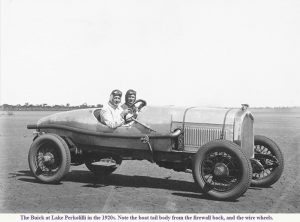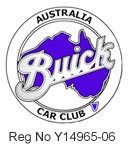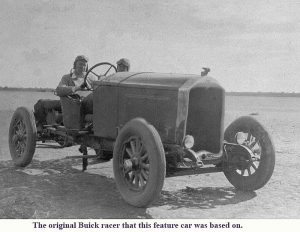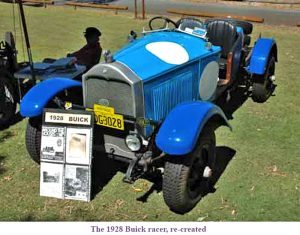 Contributed by Graeme Cocks, Fremantle Motor Museum and reproduced from Restored Cars #181 – Mar-Apr 2007 with thanks to Eddie Ford
Contributed by Graeme Cocks, Fremantle Motor Museum and reproduced from Restored Cars #181 – Mar-Apr 2007 with thanks to Eddie FordWhile motor sport in eastern Australia began developing along European lines in the 1920’s with small displacement engines in light cars, Western Australia was still the place to develop large American engines in big cars for racing. Brands such as Dodge, Auburn, Essex and Overland raced on the two mile circular circuit at Lake Perkolilli near Kalgoorlie and national 24 hour speed records were broken on the claypan in Studebakers and Chryslers. One of the first races recorded at Lake Perkolilli was in 1915 between a 45hp Cadillac, a 25hp Buick and a 35hp Studebaker. The Buick came second behind the Cadillac. Buicks raced at Lake Perkolilli in 1927 and 1928.
In 1927 the biggest race of the year included a Chrysler called Silverwings (see RC #128) which was once campaigned by Wizard Smith at Maroubra, a Bugatti Type 35, a Ford T speedster and a big Buick with a polished aluminium boat tail body. It was driven by Jack Smith of Perth who operated a hire car and taxicab business. The Buick led the way early, but Arthur Colliver driving the Chrysler soon caught him. After the Bugatti retired with engine trouble, Colliver had the race to himself, repeatedly lapping the dirt
track at more than 80mph, with the Buick coming home in second place.
A race report at the time said, ‘They made a bizarre picture bunched up on the line discharging volumes of blue smoke and making the atmosphere hideous with the deafening roar of open exhausts, the magnificent aluminium bodied Buick, the racy looking Ford transformed beyond even Henry’s recognition, the perky and nifty Bugatti built for the job, and the veteran Chrysler with its skeleton body loaded with sandbags to prevent wheel bounce at the high speeds’.
This Buick was an impressive looking car. It appeared to have been based on a Buick Standard Six built between 1925 and 1927, with more 1927 than earlier parts. It had the wire wheels, which were an option at that time and the 12 inch mechanical brakes.
The mystery of this car to Buick enthusiasts is that the exhaust pipe comes out of the body at number six cylinder on the right hand side. Buick exhausts come out the other
side but there is no record of whether the car had a different engine or whether the exhaust was routed in an unusual way. In 1928 Jack Smith returned with a Bugatti and the big silver Buick slips from race records.
In 1928 a less flamboyant Buick arrived at the Lake driven by Eric Armstrong. Eric was the son of Percy (PW) Armstrong who was one of the pioneer motor dealers in the State. PW had progressed from teamster to bicycle despatch rider across the Eastern Goldfields to importing the first motorcycle into the State. He was amongst the first to import cars into Western Australia. He built up a strong network of dealerships across the State and his son Eric ran the Kalgoorlie branch of his Armstrong Cycles and Motor Agency in 1926 selling General Motors brands including Chevrolet, Oldsmobile, Cadillac and Buick.
Eric was born in 1900 as his father’s business was expanding from bicycles to
motorcycles and cars and from a young age began to work for the family firm. He followed his father’s keen interest in anything competitive with an engine and began with grass track motorcycle racing, then progressed to motor racing.
Eric stripped a 1928 Buick Standard Six for racing, just like the record breaking Chrysler, which had been on the lake the year before. His son, Paul Armstrong, recalls his father saying he bought a book entitled ‘How to Make a Buick do 100 Miles Per Hour’ but he was disappointed by the result. It was hard work to adapt the big Buick power plants for racing and when he had to reach 75mph to qualify for the Australian Championship race at Lake Perkolilli, he could not get it up to that speed.
BUICK RACING HISTORY
Buick was not known for its racing machines in the 1920’s, but its earlier 4 cylinder cars had established the brand’s reputation in the United States. Up to 1913 Buick entered its own factory racing team with accomplished drivers Bob Burman and Louis Chevrolet at the wheel. Buicks won races all over the country but Chevrolet left to establish the Frontenac company in 1914 and Buick did not participate in much racing until the ‘junk’ formula at Indianapolis from 1930 to 1933 when its 6 and 8 cylinder motors were used.
In the 1920s Buick was one of the leading brands in the United States and built its two millionth car in late 1927. Out of 235,000 constructed in 1928, only little more than 5,000 were exported. The 1928 Standard Six differed from the 1927 with a double drop frame which reduced the height of the body by three inches and the installation of Lovejoy shock absorbers all round. They were the last Buicks before General Motors introduced its Art and Colour Department to style its cars.
Even though Eric Armstrong could not extract all the speed he wanted from his Buick, he was successful at the Lake Perkolilli event in September 1928. In the Open Handicap race he averaged 75mph over eight miles and he won the Members’ Handicap over six miles at 73mph.
Arthur Colliver in Silverwings and another Chrysler driven by Miss Hilary Smith lined up for the State Championship with Eric Armstrong in his Buick and Gilbert Anderson in a Fiat 509. A Salmson, which had lapped the course at an unofficial 96mph during practice, ‘ran’ a bearing and could not race. The car could have provided some very good competition for Colliver. When the race began Colliver and Smith established a healthy lead over the rest of the field after the first lap of the 20 lap race with Colliver two seconds faster than Smith. Colliver put his foot down and built up speed, lapping at up to 91.1mph. He won and the local writers claimed his speed was an Australian if not a world record on a natural track’.
Eric Armstrong’s Buick came third, peaking at 78mph, but was clearly outclassed by the Chrysler racer. Eric Armstrong won the prized championship in the next event in 1929, but that time he was driving a new Auburn. He then went on to race a very fast supercharged Triumph Super Seven “Imp” to a string of victories and became the founding President of the WA Sporting Car Club. He organised, competed in, and won the State’s first Grand Prix style event at Lake Perkolilli in his Triumph.
When the first ‘around-the-houses’ style motor race was held at Albany on the south coast of Western Australia in 1936, Eric Armstrong entered a Lagonda. Later, he left Perth to join the Atlantic Union company in Melbourne. After the war he joined Rhodes Motors, the metropolitan Melbourne dealer for Holden, Oldsmobile and Cadillac. Later as Managing Director he took the company onto the stock market and led its great business success before retiring in 1958. The Buick from 1927 survived for many years.
1928 was the only appearance of Eric Armstrong’s powerful Buick at Lake Perkolilli. No doubt it was taken back to the showroom, the body was placed back on the car and it was sold. Neither car is known to still exist.
60 YEARS LATER
60 years later, two enthusiasts were confronted with a pile of Buick parts left over from a 1928 roadster restoration project, but what to do with them?
Mostly the parts lay around in a shed, but for Rob Stewart of Perth, he had other ideas. His friend Stuart Syme had just completed restoring a 1928 Buick roadster and together they headed for the 1994 Gull Speed Classic at Midland on the outskirts of Perth. This ‘around-the-houses’ style regularity event was based on the successful York Flying 50 and looked like a lot of fun.
They had a pile of parts for a 1928 Buick up front including four chassis they had gathered from all over the State. They also had a faded photocopy of a Buick, which raced at Lake Perkolilli in the halcyon days of motor racing at the old claypan near Kalgoorlie in the 1920’s.
It showed a rustic Buick with a couple of seats and a cowl and not much else. The chassis they had collected were all old farm utes, which had been cut down from sedans. Since they didn’t have any bodies, building this speedster seemed like a logical thing to do.
Excited by the event Rob said to Stuart, “Righto, let’s do it.” They resolved to begin straight away and re-create the car from the pile of parts and compete at the next event in March 1995.
For most people, building a car from scratch in a year would be an insurmountable task. So many things can go wrong along the way and slow the process down, but for Rob Stewart it was achievable. Of course, it helped owning an engine machining business.
The rolling chassis was assembled with an ingenious set up using the original front and back axle, but converting the brakes to hydraulic operation with Falcon drums and a tandem master cylinder. Even though the original car, which raced at Lake Perkolilli, had wooden wheels, they are not permitted for racing under CAMS rules so plate centres were mated to 16 inch Land Cruiser rims to create a set of disc wheels. This gave the car good braking and safe wheels to compete in regularity events.
Naturally the engine came in for close attention. Alloy Jeep pistons replaced the cast iron Buick pistons and large valves from a Ford D series diesel motor were used. The main bearings still use white metal and slipper bearings were used in the big ends. The large Buick flywheel was lightened and the sump was modified to prevent oil surge when cornering hard.
A radiator core from New Zealand was used and the old brake rods were left on the car to keep the period look. The car ran a 12 volt system with a modern fuel pump connected to the original fuel tank.
The original cowl and bonnet were used up front and two simple seats were placed behind for the driver and riding mechanic. Even though the original fuel tank was used, another fuel tank was added behind the
seats and in front of two spare wheels. Four mudguards were attached to the car so that they could easily be removed for racing.
With the help of his neighbor, Glen Hodda, who is also a car enthusiast and a panel beater by trade, the Buick was completed within 10 months and was campaigned at the Gull Speed Classic on Monday March 6, 1995.
The car later competed at other venues including Goomalling in the WA wheat belt. It is now owned by Rodney Cocks who has plans to go racing once again with the old Buick speedster.
Posted 08/2007


